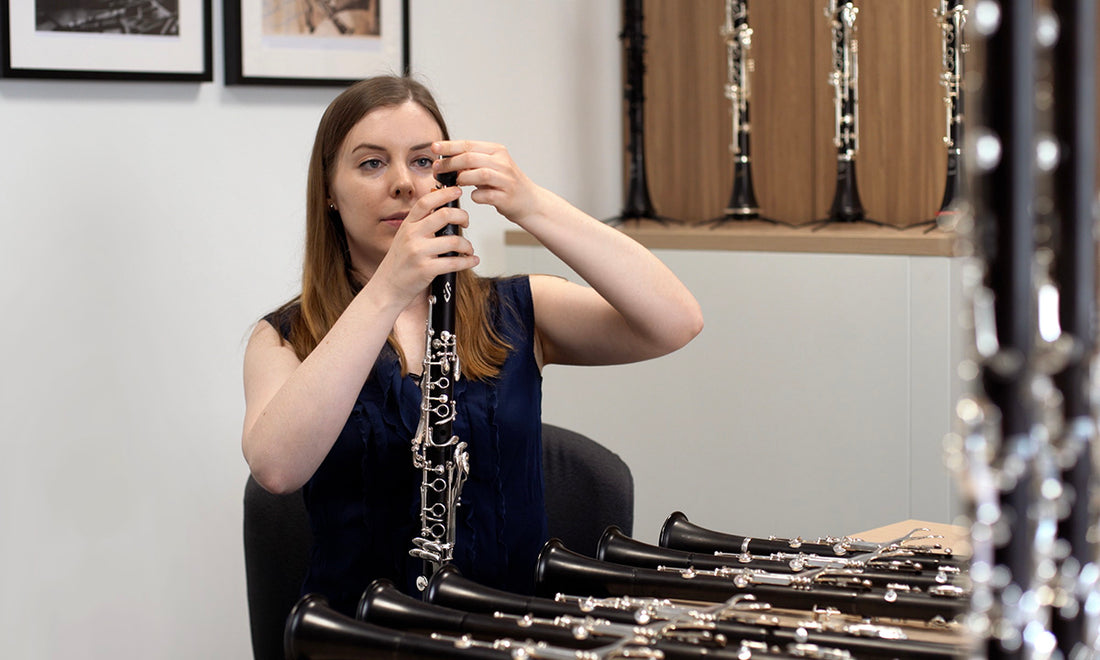How to tune a clarinet

This article is from Jenny Maclay's blog
What is tuning?
Tuning is the adjustment of musical pitches to match a reference. The reference can be a variety of things, including frequency level (A=440 Hz in the United States), or other musicians with whom you are playing. Without getting too scientific, A=440Hz means that concert pitch A above middle C will have 440 vibrations per second if it is in tune.
If you are out of tune, you are either too high (sharp) or too low (flat). The unit of measurement to indicate how flat or sharp you are is called “cents.” The more out of tune you are, the larger the cents. For example, 20 cents sharp is higher (aka more out of tune) than 10 cents sharp.
So how do you tune a clarinet? Essentially, you adjust the length of the tube (aka clarinet) to match your reference. The shorter the length of your tube, the sharper you will be (shorter=sharper). The longer the length of your tube, the flatter you will be (longer=lower). Think of a piccolo and a tuba – the shorter instrument is much higher, and the longer instrument is much lower.
Tuning adjustments
If you are sharp, pull out. If you are flat, push in. Most musicians make these adjustments between the barrel and upper joint, but you can also adjust between the upper and lower joint or the lower joint and the bell. If you find yourself having to pull out or push in too far, there could be a problem with your instrument or you might consider purchasing a different mouthpiece or barrel (more on this below).
What are some good tuning notes on clarinet? This answer may be more divisive than Alabama vs. Auburn football, but here’s my two cents (sorry for my terrible tuning pun): low C, open G, and top line F are my picks. Find two or three trustworthy notes on your clarinet, and play them with a tuner.
|
Remember that no instrument will be perfectly in tune, and the clarinet is no exception. Some notes on clarinets are more out of tune than others, and these notes can change with clarinet make and model. For example, high C# is a sharp note and low F is a flat note on all clarinets, so don’t assume you are playing a bad clarinet. It is important to learn the tuning tendencies of your instrument so that you can make educated tuning decisions. |
Observe the general tuning tendency of your tuning notes – are they all sharp? All flat? Now it’s time to make adjustments. Pull out or push in, and play your tuning notes again to see if the problem is corrected. Tuning tip: Only make adjustments to your clarinet based on your trustworthy tuning notes. You should not be constantly adjusting the length of your tube for each note that is out of tune. This is impractical and also affects the tuning of notes which might have previously been in tune. This is another reason that it is important to learn the clarinet’s tuning tendencies and the factors listed below.
After you have tuned, use a tuner as a reference and use your ears to listen to your intonation as you practice or perform. When playing with other musicians, listen and make adjustments constantly as you play to match the other musicians as closely as possible.
|
Tuning changes constantly, so the tuning adjustments you made yesterday (or even an hour ago) will not necessarily be accurate in the present or the future. Many band directors wrongly teach students to always keep their barrel pulled out the same amount every time they play, and this is inaccurate because tuning constantly changes. |
What impacts clarinet tuning
Now that you know the basics, let’s discuss a few factors and how they affect clarinet tuning.
- Temperature
Colder=Lower/Flatter
Warmer=Higher/Sharper
- Dynamics
Louder=Lower
Softer=Sharper
- Reed strength
Too soft reed=Lower/Flatter
Too hard reed=Higher/Sharper (not to mention difficult to play!)
- Embouchure pressure
Embouchure too tight=Higher/Sharper
Embouchure too loose=Lower/Flatter
- Finger height
The closer your fingers to the tone holes, the lower the pitch.
The further your fingers from the tone holes, the higher the pitch.
For example, low A is generally high, so you can keep your right hand ring finger closer to the tone hole to lower the pitch (just be careful not to actually touch the key).
- Mouthpiece
Different mouthpieces are tuned differently. For example, the Vandoren 13 series mouthpieces are tuned to A=440Hz, but Vandoren traditional mouthpieces are tuned to A=442Hz. Choose your equipment according to your tuning tendencies and ensemble requirements.
- Barrels
Shorter=Sharper
Longer=Lower
Most clarinet barrels in the United States are 65mm or 66mm, but you might need additional lengths depending on the ensemble you perform with or other factors.
|
Familiarize yourself with these elements which affect clarinet tuning and learn how to use these for your musical advantage. For example, blow warm air into your clarinet if you are waiting in a cold greenroom before performing under warm stage lights. Avoid extreme dynamics in any registers with problem notes. Acquire a selection of barrels to adapt to any tuning situation. Tuning is difficult enough, so learn as much as you can about your personal tuning tendencies to quickly adapt to any musical situation. |
► Discover the mistakes not to make on Jenny's blog
► How to Improve Your Clarinet Sound